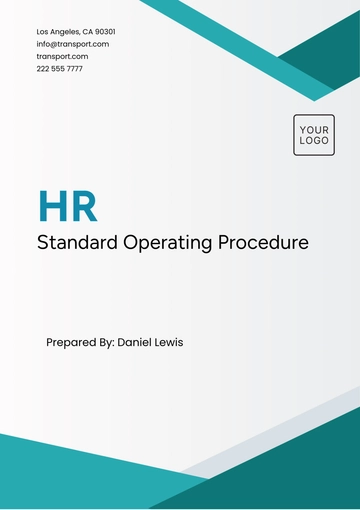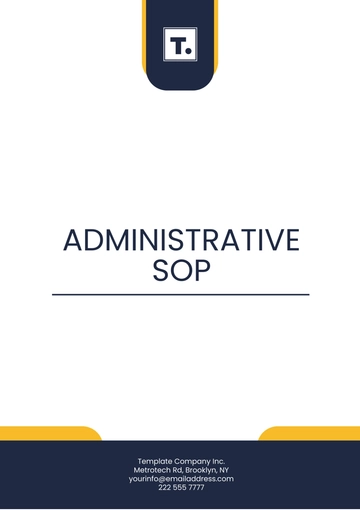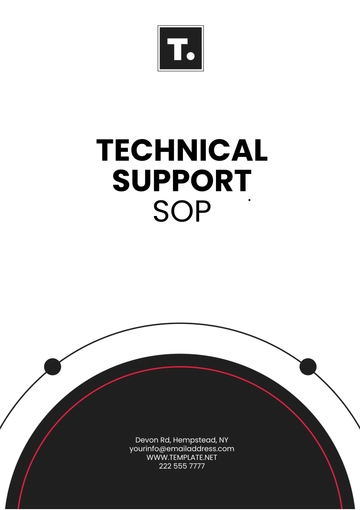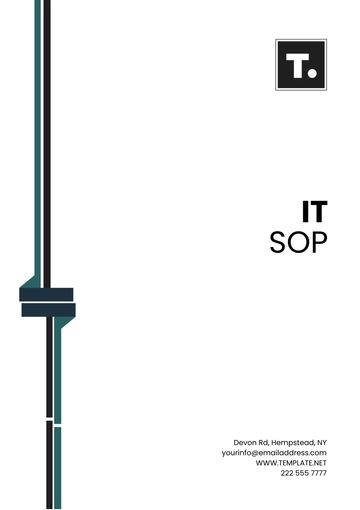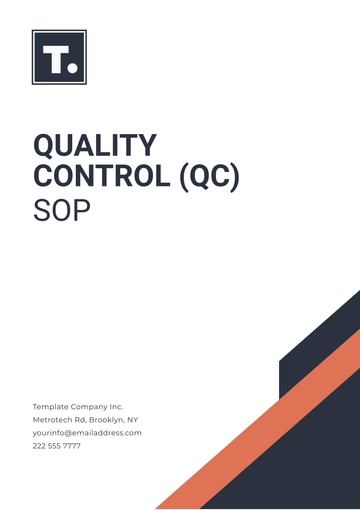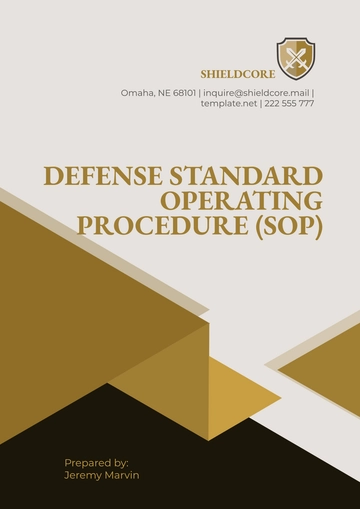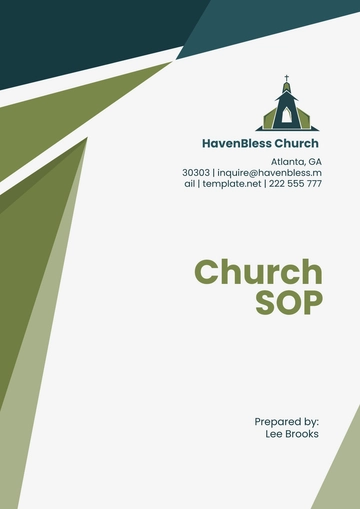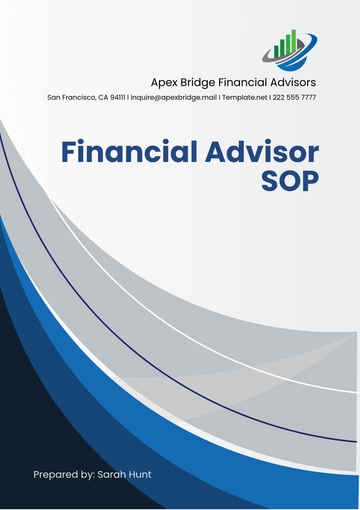Free Financial Advisor SOP
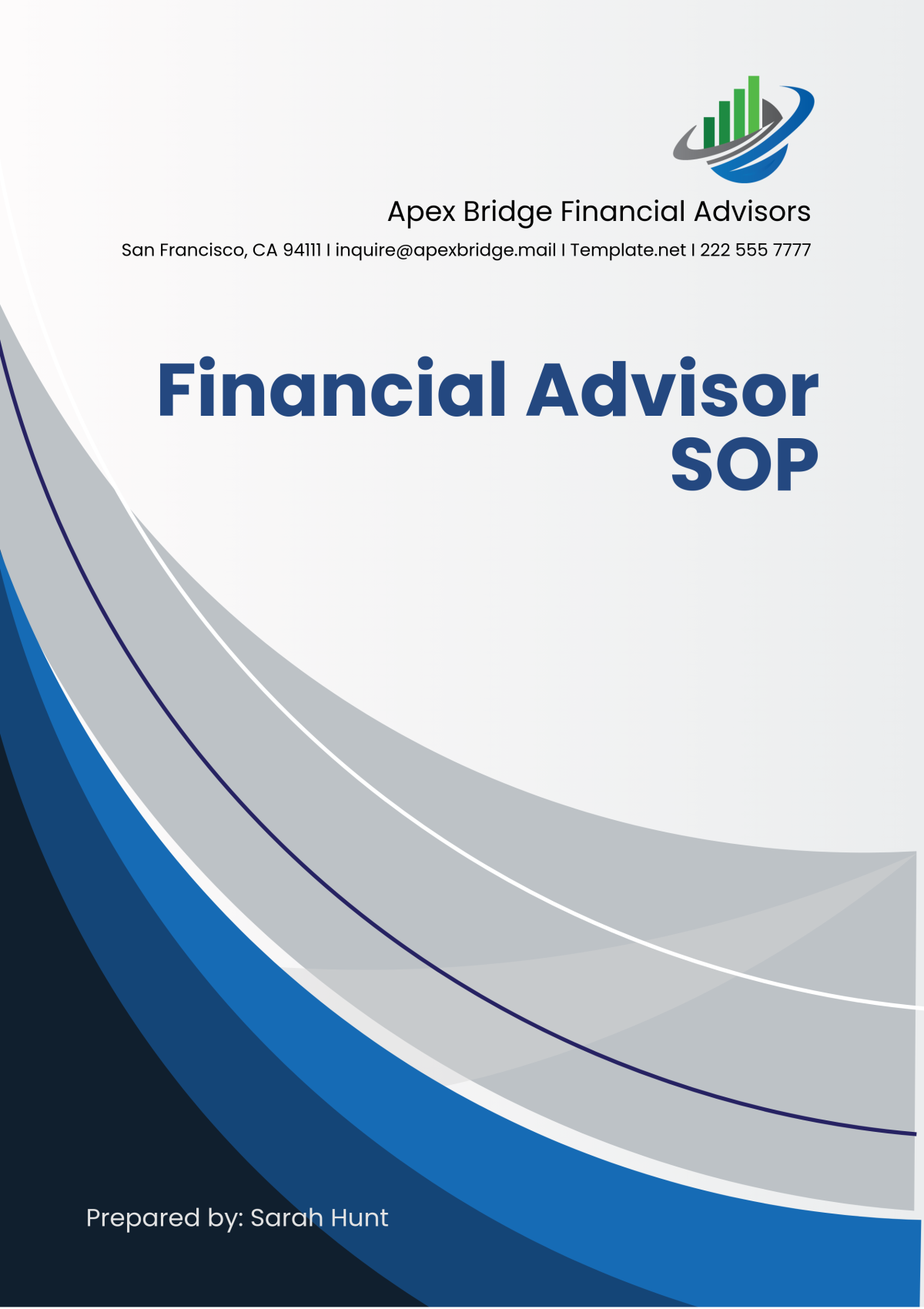
I. Introduction
A. Purpose
The purpose of this Standard Operating Procedure (SOP) is to define and standardize the activities and responsibilities of financial advisors within [Your Company Name]. This SOP ensures that all financial advisors operate within the company's policies, industry regulations, and provide the highest quality of financial advisory services to clients. Furthermore, this document serves as a comprehensive guide to ensure that every advisor adheres to the same operational framework, thereby minimizing discrepancies and fostering a uniform approach to client management. This structured approach ultimately leads to a more cohesive client experience and enhances the overall reputation of [Your Company Name] in the financial advisory space.
B. Scope
This SOP applies to all financial advisors employed by [Your Company Name], including full-time, part-time, and contracted staff. It encompasses a wide range of activities, from client engagement, financial plan creation, and portfolio management to adherence to regulatory frameworks. The SOP will be utilized by new hires during their onboarding process and by existing advisors for ongoing training. By covering every aspect of the advisory process, the SOP aims to ensure comprehensive compliance with best practices and regulatory guidelines, ultimately benefiting both the advisors and the clients they serve.
C. Objectives
The objectives of this SOP are as follows:
To establish standardized procedures for client interaction, financial plan development, and investment portfolio management to ensure consistency across the organization.
To ensure compliance with all legal, regulatory, and ethical standards, thereby reducing the risk of non-compliance penalties.
To enhance the client experience by providing clear, professional, and timely financial advice, which can foster trust and long-term relationships.
To minimize the risk of financial mismanagement or unethical conduct through rigorous guidelines and oversight.
To promote ongoing education and professional development for all financial advisors, ensuring they remain knowledgeable about industry changes and innovations.
II. Roles and Responsibilities
A. Financial Advisor
The financial advisor is responsible for providing financial advice and services to clients based on their individual needs and circumstances. The responsibilities include, but are not limited to:
Client Relationship Management
Building and maintaining strong client relationships through regular communication and personalized advice.
Understanding client financial goals, risk tolerance, and time horizons to craft tailored financial plans.
Establishing a rapport that fosters trust and ensures open dialogue, allowing clients to feel comfortable discussing their financial situations and concerns.
Financial Planning
Developing comprehensive financial plans that address retirement, investment, tax, estate, and insurance planning.
Providing clients with detailed analyses of their financial situation and future projections based on various scenarios.
Utilizing sophisticated financial planning software to create models that illustrate potential outcomes and help clients visualize their financial futures.
Portfolio Management
Recommending appropriate investment strategies and products based on client objectives, market conditions, and risk assessments.
Monitoring and rebalancing portfolios to ensure they remain aligned with the client's goals, especially in response to changing market conditions.
Conducting regular portfolio reviews to ensure that clients are on track to meet their investment objectives, making adjustments as necessary.
Compliance and Ethical Standards
Adhering to all applicable laws, regulations, and internal policies, including those set by financial regulatory bodies.
Ensuring transparency, integrity, and honesty in all financial dealings with clients to uphold the firm’s reputation.
Client Education
Educating clients on financial concepts, products, and market conditions to empower them to make informed decisions.
Offering clear and understandable explanations for complex financial strategies, including the potential benefits and risks associated with different investment options.
B. Compliance Officer
The compliance officer ensures that all financial advisors adhere to internal and external regulations. Key responsibilities include:
Reviewing financial plans and investment recommendations for compliance with legal standards, thereby protecting the firm and its advisors from potential legal issues.
Conducting regular audits of financial advisors’ practices and client files to ensure adherence to policies and identify areas for improvement.
Providing guidance and training to financial advisors on regulatory updates, helping them stay informed about changes that could impact their advisory practices.
Establishing a framework for reporting compliance breaches or ethical concerns, ensuring that advisors understand the importance of compliance and the procedures for addressing issues.
C. Senior Financial Advisor
Senior financial advisors act as mentors to junior advisors, overseeing their work and providing additional insights or recommendations when necessary. They also handle high-net-worth clients and more complex financial scenarios.
Key Responsibilities:
Overseeing junior advisors’ interactions with clients and reviewing their financial plans to ensure quality and accuracy.
Handling client escalations and complex financial queries, providing expert guidance based on years of experience.
Assisting in the development of advanced financial planning strategies for clients with assets exceeding $[5,000,000], ensuring that these clients receive tailored and sophisticated services.
Facilitating ongoing training and knowledge sharing among advisors, fostering a culture of learning and development within the advisory team.
III. Client Onboarding Process
A. Initial Client Meeting
Client Discovery
The financial advisor is responsible for gathering critical client information during the initial meeting, which includes:Current financial situation, including assets, liabilities, income, and expenses, ensuring a comprehensive understanding of the client's financial landscape.
Short-term and long-term financial goals (e.g., retirement, home purchase, education planning), which will serve as the foundation for all future recommendations.
Risk tolerance and investment time horizon, which will guide the advisor in creating a suitable investment strategy that aligns with the client's comfort level and financial objectives.
Personal and family considerations, such as health, dependents, or lifestyle preferences, to ensure that all relevant factors are taken into account when crafting the financial plan.
Compliance Documentation
During the onboarding process, financial advisors must ensure that clients provide all necessary documentation, including:Identification documents, such as government-issued IDs and proof of address, to verify the client's identity and prevent fraud.
Signed agreements acknowledging the advisor’s fiduciary responsibilities and the scope of services, ensuring that clients understand the nature of the advisory relationship.
Risk assessment forms that outline the client’s risk tolerance level, enabling the advisor to categorize the client appropriately for future investment strategies.
Client Education
Financial advisors must provide an overview of the services offered by [Your Company Name], ensuring that clients are aware of the full range of available resources and expertise.
Clients should receive an introduction to financial concepts, such as asset allocation, diversification, and the potential risks and rewards of various investment products. This foundational education will empower clients to engage more meaningfully in their financial planning process.
B. Client Data Entry
All client data collected during the onboarding process must be entered into [Your Company Name]’s Client Relationship Management (CRM) system within [3] business days. This ensures accurate record-keeping and allows the advisor to begin the financial planning process promptly.
C. Client Risk Profile and Financial Goals
Based on the data gathered in the initial meeting, the financial advisor must document the client’s risk profile and primary financial goals in the CRM system. The following factors should be considered:
Age and income level, which will affect both risk tolerance and investment strategy.
Liquidity needs, ensuring that the client has access to funds when necessary without incurring significant penalties.
Debt-to-income ratio, a critical metric in assessing financial health and capacity for additional investments.
Risk tolerance, categorized into conservative, moderate, or aggressive, to help guide investment decisions.
Investment knowledge, helping to determine the level of education and explanation required for financial products being recommended.
IV. Financial Plan Development
A. Data Analysis
After gathering the necessary client information, the financial advisor must analyze the following key areas to form the basis of the financial plan:
Income and Expenses
The advisor will review the client’s monthly and yearly income, including salary, dividends, and other sources, against their fixed and variable expenses. This will help identify surplus income that can be allocated toward savings and investments.
A detailed cash flow analysis should be conducted, ensuring that clients understand their spending patterns and areas where adjustments may be beneficial.
Assets and Liabilities
A thorough review of client assets (e.g., savings, investments, properties) and liabilities (e.g., mortgage, credit card debt) to ascertain the net worth of the client.
This evaluation will also help identify any potential debt management strategies that may need to be implemented to improve financial health.
Tax Situation
The advisor must consider the client’s current and potential future tax liabilities to develop a tax-efficient strategy. This involves reviewing the client’s income sources and possible deductions, credits, and tax-advantaged accounts that can be utilized.
The advisor should prepare strategies for minimizing tax liabilities while maximizing investment returns, particularly for higher-income clients or those in high-tax states.
B. Development of Financial Projections
Financial advisors are required to develop a long-term financial projection that spans at least [30] years. This projection must consider:
Expected growth rates of client assets, using conservative and moderate growth assumptions. The advisor should clearly explain the rationale behind the chosen rates, providing clients with realistic expectations.
Estimated inflation rates (targeting an inflation rate of [2.5]% annually) to ensure that financial projections accurately reflect the diminishing purchasing power of money over time.
Anticipated retirement age and desired lifestyle expenses during retirement, helping to calculate how much the client needs to save and invest to achieve those goals.
C. Financial Plan Drafting
Comprehensive Financial Plan
Financial advisors must draft a detailed financial plan that includes:
An overview of the client’s financial situation, including a summary of assets, liabilities, income, and expenses.
Clearly defined financial goals and the timeframes associated with each.
Strategies for achieving each goal, including recommended investment products and approaches to debt reduction.
A comprehensive risk management strategy, including insurance products that may be necessary to protect the client’s financial future.
Review and Revisions
After the initial draft is prepared, the financial advisor must schedule a follow-up meeting with the client to review the plan.
Advisors should encourage feedback, allowing clients to express any concerns or request modifications to better align the plan with their expectations. This collaborative approach fosters trust and ensures client satisfaction with the financial plan.
V. Investment Strategy Implementation
A. Investment Policy Statement (IPS)
Creating the IPS
Financial advisors are required to create an Investment Policy Statement (IPS) for each client, outlining:
The client’s investment goals and objectives.
The target asset allocation based on the client’s risk profile and investment horizon.
Guidelines for selecting investments, including acceptable and prohibited asset classes or individual securities.
A rebalancing strategy, detailing how frequently portfolios will be reviewed and adjusted to align with the target allocation.
Client Approval
Once the IPS is drafted, it must be presented to the client for review and approval before any investments are made. This ensures that clients have a clear understanding of their investment strategy and are comfortable with the guidelines set forth.
B. Investment Execution
Order Placement
Financial advisors are responsible for executing trades in alignment with the approved IPS. This involves selecting appropriate brokerage platforms that offer competitive fees and efficient execution.
Advisors must keep detailed records of all trades executed on behalf of clients, including trade dates, amounts, and reasoning for each transaction.
Fee Transparency
Advisors should clearly communicate all fees associated with investment transactions to clients. This includes trading fees, management fees, and any other costs that may impact investment returns.
Transparent communication helps build trust and ensures clients are fully aware of the costs associated with their investments.
C. Ongoing Portfolio Management
Performance Monitoring
Advisors must continually monitor the performance of client portfolios against benchmarks to evaluate effectiveness and determine necessary adjustments.
This includes reviewing individual asset performance and overall portfolio returns, providing clients with a clear understanding of how their investments are performing.
Rebalancing Strategy
Financial advisors should implement the rebalancing strategy outlined in the IPS to ensure that portfolios remain aligned with the client’s risk profile and investment goals.
Rebalancing should occur at least annually or more frequently if significant market fluctuations occur. Advisors must communicate any changes to clients promptly, explaining the rationale behind the adjustments.
VI. Compliance and Regulatory Adherence
A. Regulatory Framework
Understanding Regulations
Financial advisors must remain informed about the laws and regulations governing the financial advisory industry, including those established by the Securities and Exchange Commission (SEC), Financial Industry Regulatory Authority (FINRA), and state regulatory bodies.
This knowledge is essential for ensuring that all advisory activities are compliant and minimizing the risk of legal penalties or reputational damage to [Your Company Name].
Documenting Compliance
Advisors must maintain thorough documentation of all client interactions, financial plans, and transactions to demonstrate compliance with regulatory requirements.
Regular audits should be conducted to review documentation and adherence to internal policies. These audits can help identify areas of risk or potential non-compliance, allowing for timely corrective actions.
B. Ethical Conduct
Fiduciary Responsibility
Financial advisors are obligated to act in the best interest of their clients at all times. This involves putting client needs ahead of personal or firm interests, thereby maintaining a high standard of professionalism and integrity.
Advisors should avoid conflicts of interest and disclose any situations where their personal financial interests may be at odds with the client’s. Transparency is key to fostering trust in the advisor-client relationship.
Transparency and Honesty
Advisors must communicate openly and honestly with clients regarding fees, services, and risks associated with investment products. This includes providing clients with a clear breakdown of all costs associated with their financial plan and investments.
Building a culture of transparency ensures clients feel valued and understood, ultimately leading to stronger, more trusting relationships.
Client Confidentiality
Protecting client information is paramount. Advisors must adhere to strict data protection policies and practices to maintain the confidentiality of all client records.
Sensitive information should only be shared with authorized personnel, and advisors must ensure that all client communications are conducted in secure environments, protecting against unauthorized access or breaches.
C. Continuing Education and Professional Development
Ongoing Training
Financial advisors are required to engage in continuing education programs, including industry seminars, webinars, and courses to stay updated on regulatory changes and financial product developments.
At least [20] hours of training must be completed annually to maintain competency and uphold [Your Company Name]'s standards of practice. Keeping abreast of industry trends ensures that advisors provide the most relevant and effective services to their clients.
Certifications and Licensing
Advisors must hold and maintain relevant certifications and licenses required by law, such as the Certified Financial Planner (CFP) or Chartered Financial Analyst (CFA).
Regular audits of certifications and licenses should be conducted by the compliance officer to ensure that all advisors are compliant and operating within legal boundaries.
VII. Client Review Process
A. Regular Review Meetings
Annual Review
Financial advisors must schedule an annual review meeting with each client to assess their financial situation and review the performance of investments. This meeting serves as an opportunity to discuss any changes in the client's life circumstances, market conditions, or financial goals.
Advisors should prepare a detailed agenda for the meeting that includes topics such as market updates, portfolio performance, and any significant life changes affecting the client. Meeting notes should be documented and entered into the CRM system for future reference.
Ad Hoc Reviews
Clients should be encouraged to request meetings whenever significant life events occur, such as marriage, divorce, retirement, or the birth of a child. Financial advisors must remain flexible and responsive to client needs.
These ad hoc meetings can be crucial for adjusting financial plans to align with new circumstances, reinforcing the advisor's commitment to client success and well-being.
B. Performance Evaluation
Investment Performance
During review meetings, financial advisors must discuss how the portfolio has performed compared to benchmarks and the client's financial goals. This evaluation should include a detailed analysis of asset allocation and individual investment performance.
Advisors should also analyze any underperforming investments and consider necessary adjustments or reallocation strategies to enhance overall portfolio performance.
Goal Assessment
Advisors should assess progress toward achieving the client's financial goals, discussing any shortfalls or areas for improvement. This may involve adjusting timelines or strategies based on current performance and market conditions.
The advisor must document any changes made during the review meetings in the CRM system to ensure accurate record-keeping and ongoing alignment with the client's objectives.
Client Feedback
Financial advisors should solicit client feedback on the advisory relationship and services provided. This feedback can be collected through surveys or direct discussions during review meetings.
Gathering client insights allows advisors to understand their clients' perceptions and make necessary adjustments to enhance service delivery. Client satisfaction is crucial for retaining long-term relationships and fostering referrals.
VIII. Documentation and Record-Keeping
A. Client Documentation
File Organization
Financial advisors must maintain organized client files that include essential documentation such as:
Client agreements, including retainer contracts and engagement letters, which outline the terms of the advisory relationship.
Comprehensive financial plans and investment recommendations, documenting the rationale behind each strategy proposed to the client.
Meeting notes from all client interactions, capturing key discussions, decisions made, and action items.
Communication records, including emails, phone calls, and any correspondence related to client service and advice.
Retention Policy
Documentation must be retained for a minimum of [7] years after the client relationship ends, ensuring compliance with regulatory requirements and [Your Company Name]’s policies.
Secure storage solutions must be utilized to protect client information, including both digital and physical documentation, ensuring that sensitive data is accessible only to authorized personnel.
B. CRM System Usage
Data Entry and Updates
Financial advisors must utilize [Your Company Name]'s Client Relationship Management (CRM) system to manage client information effectively. All client interactions, financial plans, and communications should be entered into the CRM system within [2] business days of occurrence.
Regular updates must be made to reflect changes in client information, investment performance, and planning strategies. This practice allows for easy access to up-to-date client data and enhances the efficiency of the advisory process.
Security Measures
Advisors must adhere to data security protocols to ensure the integrity and confidentiality of client information in the CRM system. This includes implementing password protection, encryption, and multi-factor authentication for access to sensitive data.
Regular audits of CRM system access and usage should be conducted by the compliance officer to identify any potential security risks or breaches.
IX. Continuous Improvement
A. Review of Procedures
Annual Review of SOP
This SOP should be reviewed annually to ensure it remains aligned with industry best practices, regulatory changes, and the evolving needs of clients. The review process should involve input from financial advisors, compliance officers, and management to incorporate diverse perspectives.
Any changes made to the SOP should be documented, and all employees must receive updated training on any new procedures or guidelines implemented.
Feedback Mechanisms
Financial advisors should be encouraged to provide feedback on the SOP and suggest improvements based on their experiences and challenges faced in the field.
Establishing a formal feedback mechanism allows for ongoing enhancements to the SOP, ensuring it remains relevant and effective in guiding advisory practices.
B. Training and Development
Ongoing Training Programs
Regular training programs should be organized to enhance the knowledge and skills of financial advisors. These programs should cover various topics, including regulatory updates, new financial products, and advanced financial planning techniques.
Utilizing both internal and external training resources will ensure that advisors are well-equipped to serve their clients effectively.
Performance Evaluation
Financial advisors should undergo performance evaluations at least annually, assessing their adherence to the SOP, client satisfaction, and overall contributions to [Your Company Name].
Feedback from these evaluations should be used to identify areas for professional growth and development, fostering a culture of continuous improvement and excellence within the advisory team.
- 100% Customizable, free editor
- Access 1 Million+ Templates, photo’s & graphics
- Download or share as a template
- Click and replace photos, graphics, text, backgrounds
- Resize, crop, AI write & more
- Access advanced editor
Standardize operations with the Financial Advisor SOP Template from Template.net. This editable and customizable template provides guidelines for various processes, ensuring consistency and quality in service delivery. Use our Ai Editor Tool to adapt it to your practice’s specific needs, enhancing operational efficiency.





